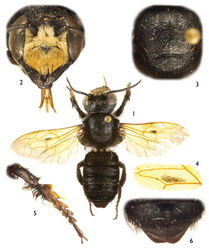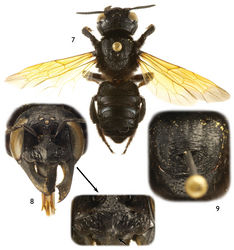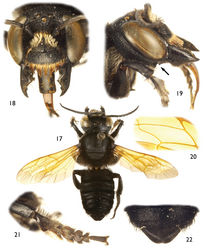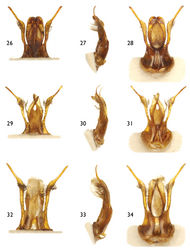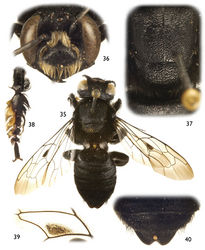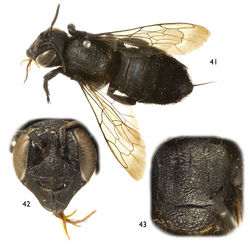Chalicodoma (Alocanthedon) atratiforme
| Notice: | This page is derived from the original publication listed below, whose author(s) should always be credited. Further contributors may edit and improve the content of this page and, consequently, need to be credited as well (see page history). Any assessment of factual correctness requires a careful review of the original article as well as of subsequent contributions.
If you are uncertain whether your planned contribution is correct or not, we suggest that you use the associated discussion page instead of editing the page directly. This page should be cited as follows (rationale):
Citation formats to copy and paste
BibTeX: @article{Engel2011ZooKeys101, RIS/ Endnote: TY - JOUR Wikipedia/ Citizendium: <ref name="Engel2011ZooKeys101">{{Citation See also the citation download page at the journal. |
Genus: Chalicodoma
Name
Chalicodoma atratiforme (Meade-Waldo) comb. n. – Wikispecies link – Pensoft Profile
- Megachile atratiformis Meade-Waldo 1914[1]: 456.
Additional material
Malaysia (Peninsular): 3♀♀, Pahang, Batu Balai Estate, 18 March 1927, E. Seimund, Ex F.M.S. [Federated Malay States] Museum (NHML); 1♂, 1♀, Negri Sembilan, Gunong Angsi, 2000–2790’ [feet], April 1918, Ex F.M.S. [Federated Malay States] Museum (NHML).
Thailand: 1♀, Uthai Thani Province [western Thailand], Huay Kha Khaeng Wildlife Sanctuary, 15º36’ N, 99º20’ E, 1.xi.1995 [1 November 1995], J. Gazhoul, captured at Dipterocarpus obtusifolius Teijsman & Miquel (Dipterocarpaceae), D.B. & M.W. Baker Collection (SEMC); 1♀, 150 n.w. Bangkok, Huay Kha Khaeng, 5.xi.1995 [5 November 1995], J. Ghazoul (NHML).
Diagnosisn
The female of this species can be recognized by the clypeus lacking a medioapical tubercle, short mandibles (Fig. 45), labrum with an apical fringe of erect setae running along relatively straight apical margin, and the yellow wings (Fig. 44). The male can be recognized by the dense setal patch in forewing medial cell, tergum VI with shallow medioapical concavity on preapical carina, protibia with outer, apical surface not depressed, and genitalia as in figures 32–34.
Remarks
It should be noted that Meade-Waldo’s (1914) material from “Middle Tenasserim” is not conspecific with his type (B.M. Type Hym.17a2037) for Chalicodoma atratiforme and are actually specimens of Chalicodoma odontophorum. Additionally, despite Cockerell’s (1927)[2] assignment of the subspecies Chalicodoma atratiforme sininsulae (Cockerell) (Type USNM 70455; ♀; Turtle Island [Koh Tao], Gulf of Siam; visum) to Meade-Waldo’s species, his female has nothing whatever to do with Chalicodoma atratiforme and is instead a synonym of Callomegachile (Callomegachile) fulvipenne (Smith 1879[3]) (syn. n.).
Key to Species of Alocanthedon
Note: The female of Chalicodoma apoicola is unknown.
Taxon Treatment
- Engel, M; Gonzalez, V; 2011: Alocanthedon, a new subgenus of Chalicodoma from Southeast Asia (Hymenoptera, Megachilidae) ZooKeys, 101: 51-80. doi
Other References
- ↑ Meade-Waldo G (1914) Notes on the Hymenoptera in the collection of the British Museum, with descriptions of new species. Annals and Magazine of Natural History, Series 8, 14:450-464.
- ↑ Cockerell T (1927) Bees collected by Dr. H.M. Smith on Turtle Island (Koh Tao), Gulf of Siam. Proceedings of the Entomological Society of Washington 29 (7):160-162.
- ↑ Smith F (1879) Descriptions of New Species of Hymenoptera in the Collection of the British Museum. Taylor and Francis, London, xxi+240 pp.
Images
|
